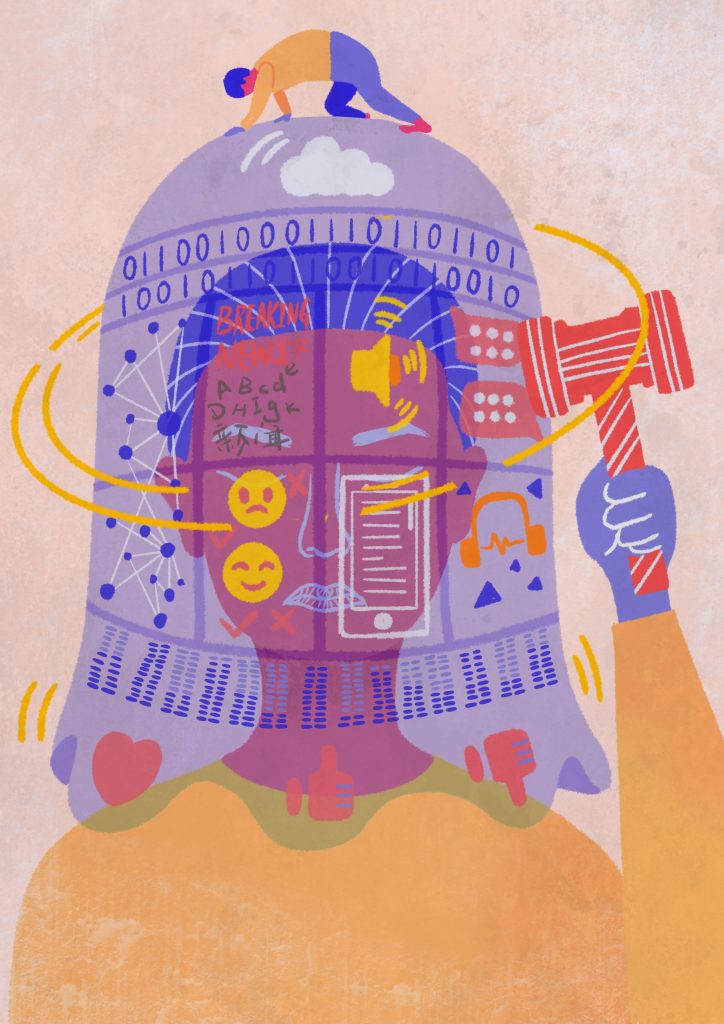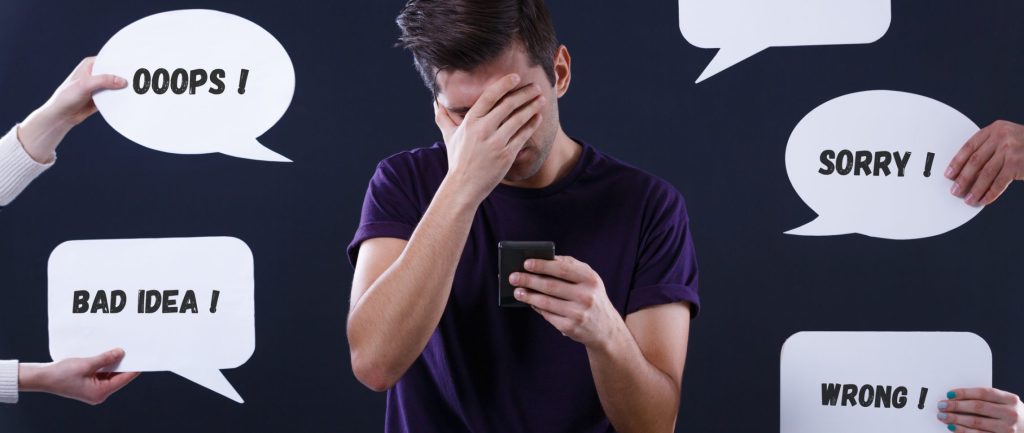TOPICS: Lack of Diversity Network technology Platform Social media Social stickiness Algorithm Public Domain TikTok
POSTED BY: Yuting Zou 02/10/2023

What is An Information Cocoon?
Cass Sunstein proposed the concept of “Information cocoon” is the public’s information needs are not comprehensive, often follow the interests, and over time, they will be trapped in a cocoon-like a cocoon (Sunstein, 2008). This stems from our inevitable preconceptions and the fact that we all like to hear agreement, both individuals and groups. “Information cocoon” is an alternative perspective of the impact of the network. The substantial rise of algorithm intelligent recommendation has become the most famous content distribution method at present, providing users with more accurate and personalised information services while bringing changes to the field of communication (Sunstein, 2008). Despite this, however, the hidden danger of forming an “information cocoon” is also gradually becoming more prominent, causing people to become increasingly vigilant about the possibility of alienation from new technologies.
The Inevitability of the Existence of Information Cocoons
Personal Subjective choice is one of the important reasons leading to information cocoon

What Are the Most Important Characteristics of a Successful Online Community? © 2022 by Darleene Rasmussen is licensed under Attribution-NoDerivatives 4.0 International
- The wide range of Information causes users to make trade-offs
The massive amount of information provides users with more power and agency to browse, allowing each user to receive information they are interested in. People tend to be more willing to contact with their attitudes, views, and positions consistent with the information and try to avoid their contradicting views and values to the content. The Internet community breaks through geographical restrictions forming a “virtual community” of information network relations with similar interests and emotional resonance (Gillespie, 2018), providing free access to online information. Thus, Sunstein (2008) argues, users must choose between countless news stories, resulting in each user choosing the information they want to receive according to their own interests and preferences. The result is that everyone’s world is just what they want it to be, not what it should be. Therefore, the individual’s selective access to information is the decisive factor in the formation of the “Information Cocoon”, the so-called “Cocoon” is built by the user.
Network technology and platform are the important conditions to promote the information cocoon
Network technology and platform-enabled information cocoon mainly include recommendation technology and filtering technology. Personalised recommendation technology according to the user’s browsing, search, attention, likes, favourites, forwarding, and other historical behaviour data, in-depth mining, and analysis of the user’s information preferences, and constantly build a user portrait to recommend interested content for users, provide personalised information customisation services (He et al., 2023). To a certain extent, personalised recommendation technology can reduce the user’s information cost, meet the user’s information needs, and improve the user’s information experience. In the long run, the user’s information receiving range will be limited to a relatively closed information field, accelerating the formation of an “Information cocoon”. Algorithms are used by online retailers like TikTok to provide personalised product recommendations based on customers’ browsing and purchase history (Meiselwitz et al., 2022). The logical factor of forming the “information cocoon” is the algorithm the application relies on to push information (Sunstein, 2008). The more the information platform pays attention to recommending personalised content to users, the more it relies on the algorithm to push information. In this way, algorithms can provide users with more accurate and boundary information services, promote transaction completion, and increase the possibility of additional purchases.
Information Cocoon Hazards

“TikTok app” by Solen Feyissa is licensed under CC BY-SA 2.0.
- The polarisation of network groups and the loss of social cohesion
The gradual reduction of direct contact between people, society, and communities, coupled with thousands of personalised customised information, makes users lack common experience and damages social stickiness. Although TikTok is a platform for aggregating short video content, the content is filtered due to the attention mechanism and recommendation mechanism, and the content that individuals contact is the filtered content (Zhao, 2021). In Democracy and the problem of free speech, Sunstein (1995) argues that “most citizens should have some degree of shared experience.” . Without the ability to share experiences, a heterogeneous society will find it challenging to deal with social problems and to understand each other easily. Shared experiences, especially those shaped by the media, provide a certain social cohesiveness.” Sunstein (1995) believes that a communication system that eliminates this shared experience will bring a series of problems and will also bring about social division. TikTok’s following and recommendation mechanism excludes the public and open information environment, but the information environment of “personal daily news” is set by oneself. The social public information that should be known is excluded from preferences, and the content received results from individual subjective choice, lacking an objective information environment outside of choice. Users who use TikTok as a single information acquisition channel have information blind spots, are limited in their field of vision, cannot know social information and understand others, and become a single individual, which reduces the adhesion between individuals and society, reduces the shared experience between citizens, and challenges public communication and social integration.

Online fights that caused permanent reputation damage © 2019 by Jennifer Bridges is licensed under CC BY-ND 4.0
- The “Information cocoon” conceals the individual and intensifies the extreme thinking
The information cocoon will lead to group polarisation, resulting in one-sided thinking and bias. Content in TikTok is pushed according to the user’s tag, indicating that the platform has labeled the user’s behaviour (Zhao, 2021). Labeled users use the “selective psychological mechanism” to find users close to their labels, forming a group with the same label. James Stoner (1961) put forward the idea of group polarisation, he believes that in an organisational group, people’s decisions are influenced by the group, hence, they tend to make more extreme decisions then compared to deciding alone. At TikTok, the personalised push mechanism makes it easier for individuals with the same preferences to find organisations and form groups. Filtering TikTok’s personalised recommendations brings the same user demographics together, and additionally to the previous circle of friends based on social relationships, they form their own small groups (Zhao, 2021). Groups are characterised by “poor reasoning, eagerness to act, suggestibility and emotional exaggeration.” (Zhao, 2021). This makes people’s emotions easily infected in the group, driving them to respond to public opinion events with more extreme views and behaviours, resulting in the polarisation of the group. TikTok’s personalised algorithm recommendation will amplify preferences, and the user information receiving mode with reduced differences will continue to differentiate. Groups gather the same people; group opinions, norms and attitudes are the same, with individual voices being constantly echoed, thus aggravating group polarisation.
- Facilitate the application of unreasonable algorithms on the platform
The information cocoon effect has largely assisted TikTok in understanding the platform’s users whilst encouraging lousy behaviour such as “big data killing” and “algorithmic discrimination.” The comment section for male TikTok users recommended videos differs from that of female users. Through big data and algorithms, the platform allows male and female users to unconsciously accept information and produce cognitive impact, thus fostering the opposite of gender. In the new media era, the information that users contact should be part of a comprehensive, diversified, open, and accessible environment. Amongst those homogenised information, users’ views are increasingly amplified and strengthened, and the negative information is increasingly narrowed until it disappears. Individual visions will become limited, narrowed, and blinded. In the long run, users lack communication with other ideas, “overly narrow information acceptance surface is easy to cause the solidification of thinking, which may cause irrational and stubborn perceptions and analysis of certain matters and problems.
The Path of Liberation of the Shackles of “Information Cocoon”
- Individuals and governments
Users gradually realise the existence of an information cocoon and consciously want to break the phenomenon of an information cocoon. Since the algorithm is the key factor in forming the information cocoon, improving the algorithm is an effective way to break the information cocoon. TikTok used algorithms to recommend personalised user contents. Thus the algorithm can be improved to diversify information push. Pushing the opposite point of view to the user is the exchange of different points of view and the collision of ideas for the user. It also strengthens their critical thinking ability so that the user has a self-thinking rather than unconscious reception of information (Massanari, 2016). The result of the “information cocoon” is that individuals are enclosed in their information range, so strengthening the public’s participation can also effectively crack the “information cocoon” (Massanari, 2016). Allowing universities to build new media accounts and platforms, guide students to participate in them, support different opinions, encourage communication among students, and spread information about mainstream consciousness and core values, which to a large extent cracked the “information cocoon.” Secondly, users are the main body of Internet users, and the information in the network is easy to affect the groups forming values. This form of emancipation can also be emulated in the social sphere. Local governments can also lead in opening we-media platforms and accounts, strengthening the public’s participation in social issues and consolidating the dominant position of mainstream ideologies (Massanari, 2016). The information cocoon has yet to be appropriately managed in all facets. However, most users in society want to break the phenomenon of the cocoon room under great consciousness.
References
Arthur, J. (1961). A Comparison of Individual and Group Decisions Involving Risk. Massachusetts Institute of Technology.
Gillespie, T. (2018). Custodians of the Internet: Platforms, Content Moderation, and the Hidden Decisions That Shape Social Media. Yale University Press.
He, Y., Liu, D., Guo, R., & Guo, S. (2023). Information Cocoons on Short Video Platforms and Its Influence on Depression Among the Elderly: A Moderated Mediation Model. Psychology Research and Behavior Management, Volume 16(37426388), 2469–2480. https://doi.org/10.2147/prbm.s415832
Katz, E., & Lazarsfeld, P. F. (1955). Personal influence; the part played by people in the flow of mass communications. Free Press.
Lazarsfeld, P. F. (1944). PEOPLE’S CHOICE : how the voter makes up his mind in a presidential campaign. Columbia Univ Press.
Massanari, A. (2016). #Gamergate and The Fappening: How Reddit’s algorithm, governance, and culture support toxic technocultures. New Media & Society, 19(3), 329–346. https://doi.org/10.1177/1461444815608807
Meiselwitz, G., Moallem, A., Zaphiris, P., Ioannou, A., Sottilare, R. A., Schwarz, J., & Fang, X. (2022). HCI International 2022 – Late breaking papers. Interaction in new media, learning and games: 24th International Conference on Human-Computer Interaction, HCII 2022, virtual event, june 26–july 1, 2022, proceedings. Springer Nature.
Monisight. (2023). Are we living in information cocoons societies. Www.youtube.com. https://www.youtube.com/watch?v=EFbIvMkJSGQ
Sunstein, C. R. (1995). Democracy and the Problem of Free Speech. Simon and Schuster.
Sunstein, C. R. (2008). Infotopia : how many minds produce knowledge. Oxford University Press.
Zhao, Z. (2021). Analysis on the “Douyin (Tiktok) Mania” Phenomenon Based on Recommendation Algorithms. E3S Web of Conferences, 235, 1–10. https://doi.org/10.1051/e3sconf/202123503029